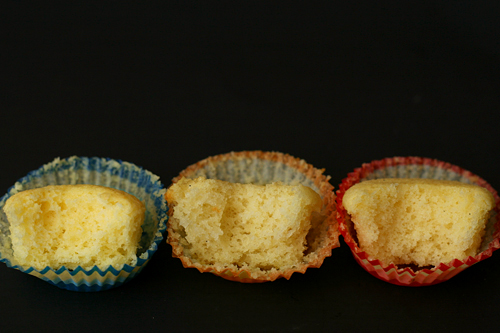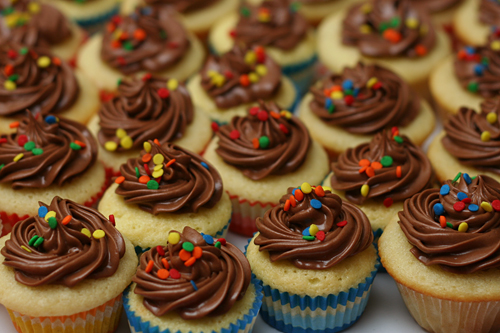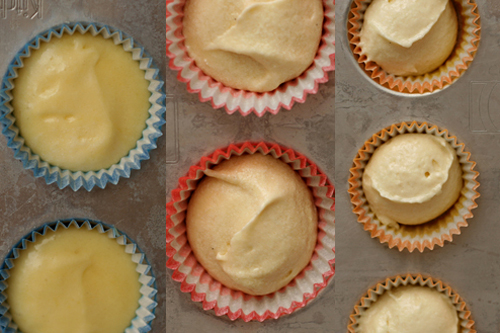I was going to wait to post this because now I want to do more yellow cake experiments. But this week I have a couple batches of cookies I want to make, and last week it was bread pudding and chocolate mousse, and next week it’ll be something else. By the time I find an opportunity to make more yellow cake, I’ll have forgotten everything about this batch.
The three recipes I chose for this comparison are Cooks Illustrated’s Fluffy Yellow Cake (CI), Martha Stewart’s Yellow Butter Cake (MS), and Smitten Kitchen’s Best Birthday Cake (SK). Like all yellow cakes, they all include butter, whole eggs (unlike white cake, which only uses the whites), granulated sugar, vanilla, salt, leavener, flour (cake or all-purpose), and dairy (whole milk or buttermilk). I baked them all as mini cupcakes at the same temperature for the same amount of time. I used the same size scoop to transfer the batter to the muffin cups.
CI (blue wrappers), which uses cake flour and buttermilk, is unique among these recipes in its inclusion of oil and extra egg yolks. It is also mixed like a chiffon cake, in which the dry ingredients and liquid ingredients (including melted butter) are combined, then beaten egg whites are folded in.
MS (red wrappers) uses a mixture of all-purpose flour and cake flour, as well as whole milk instead of buttermilk (it is therefore missing the baking soda the other two recipes require to balance the acidity of the buttermilk). It is mixed using the creaming method, in which the butter and sugar are combined, the eggs are added, then the milk and dry ingredients.
SK (yellow wrappers) also uses cake flour and buttermilk. There are no tricks up this cake’s sleeves. It is also mixed with the creaming method.
CI (blue) was buttery and moist with a nice sponginess. The top was a little sticky (easily covered up with frosting, but we were testing them plain) and crisp. It was my and Dave’s favorite.
MS (red) was less sticky and fluffier, but it was also less buttery, and, to be honest, a little bland. It has half the salt as the other recipes, so that’s probably the culprit, although it could be the use of whole milk instead of buttermilk.
SK (yellow) had a nice, buttery flavor, but a solid, flat top. For cupcakes, the flat-topped spreading is a deal breaker for me, but I believe it would be fine for a layer cake. And because this cake has over three times more baking soda than CI, I suspect that cutting it in half would solve the spreading problem, which I attribute to overrising.

(sorry I switched the order around in this photo)
So the cake with the best texture (MS) – fluffy, slightly domed, with no stickiness or overly hard tops – had the least impressive flavor. I’m inclined to think that it would be easier to bump up the flavor of that recipe than it would be to adjust the texture of the others. I would also love to try SK as a layer cake and/or with less baking soda. To complicate matters further, a reader recently pointed out another yellow cake comparison with several more recipes I’d like to try.
In the meantime, Cooks Illustrated’s Fluffy Yellow Layer Cake has the best balance of these three recipes of full, buttery flavor and a light texture. And once the cakes were smothered with chocolate frosting, I couldn’t tell the difference between them anyway.
(Oh, were you wondering what the best chocolate frosting is? It turns out I compared three chocolate frosting recipes in the same (exhausting) night. I’ll discuss those next.)
One year ago: Oatmeal Pancakes
Two years ago: Red Velvet Cake comparison (odd coincidence)
Three years ago: Potstickers
Printer Friendly Recipe
Fluffy Yellow Layer Cake (from Cooks Illustrated)
Makes two 9-inch round cakes
2½ cups (10 ounces) cake flour, plus extra for dusting pans
1¼ teaspoon baking powder
¼ teaspoon baking soda
¾ teaspoon table salt
1¾ cups (12.25 ounces) sugar
10 tablespoons unsalted butter, melted and cooled slightly
1 cup buttermilk, at room temperature
3 tablespoons vegetable oil
2 teaspoons vanilla extract
6 large egg yolks plus 3 large egg whites, at room temperature
1. Adjust an oven rack to the middle position and heat the oven to 350 degrees. Grease two 9-inch cake pans and line the bottoms with parchment paper. Grease the paper rounds, dust the pans with flour, and knock out the excess. Whisk the flour, baking powder, baking soda, salt and 1½ cups (10.5 ounces) sugar together in a large bowl. In a 4-cup liquid measuring cup or medium bowl, whisk together the melted butter, buttermilk, oil, vanilla, and yolks.
2. In the clean bowl of a stand mixer fitted with the whisk attachment, beat the egg whites at medium-high speed until foamy, about 30 seconds. With the machine running, gradually add the remaining ¼ cup (1.75 ounces) sugar; continue to beat until stiff peaks just form, 30 to 60 seconds (whites should hold peak but mixture should appear moist). Transfer to a bowl and set aside.
3. Add the flour mixture to the now-empty mixing bowl fitted with the whisk attachment. With the mixer running at low speed, gradually pour in the butter mixture and mix until almost incorporated (a few streaks of dry flour will remain), about 15 seconds. Stop mixer and scrape the whisk and sides of the bowl. Return the mixer to medium-low speed and beat until smooth and fully incorporated, 10 to 15 seconds.
4. Using rubber spatula, stir ⅓ of the whites into the batter to lighten, then add the remaining whites and gently fold into the batter until no white streaks remain. Divide the batter evenly between the prepared cake pans. Lightly tap the pans against the counter 2 or 3 times to dislodge any large air bubbles.
5. Bake until the cake layers begin to pull away from sides of pans and a toothpick inserted into the center comes out clean, 20-22 minutes. Cool the cakes in the pans on a wire rack for 10 minutes. Loosen the cakes from the sides of the pan with a small knife, then invert onto a greased wire rack and peel off the parchment. Invert the cakes again and cool completely on rack, about 1½ hours.
Printer Friendly Recipe
Yellow Butter Cake (from Martha Stewart via Annie’s Eats)
Makes two 9-inch round cakes
16 tablespoons (2 sticks) unsalted butter, at room temperature, plus more for greasing pans
1½ cups (7.2 ounces) all-purpose flour, plus more for dusting pans
1½ cups (6 ounces) cake flour
1 tablespoon baking powder
½ teaspoon salt
1¾ cups (12.15) granulated sugar
4 large eggs, room temperature
2 teaspoons vanilla extract
1¼ cups milk, at room temperature
1. Preheat the oven to 350˚ F. Line the bottoms of two 9-inch round cake pans with parchment paper. Butter and flour the edges of the pans, tapping out the excess; set aside. In a medium bowl, combine the all-purpose flour, cake flour, baking powder, and salt; whisk together to blend well and set aside.
2. In the bowl of an electric mixer, combine the butter and sugar. Beat on medium-high speed until light and fluffy, about 4 minutes, scraping down the bowl as needed. Mix in the eggs one at a time, beating well after each addition. Blend in the vanilla. With the mixer on low speed, add in the dry ingredients in three additions, alternating with the milk. Beat each addition just until incorporated.
3. Divide the batter between the prepared baking pans. Bake, rotating the pans halfway through baking, until the cakes are golden and a toothpick inserted in the center comes out clean, 30-35 minutes. Transfer the pans to a wire rack and let cool 20 minutes. Run a knife around the edge of the pans to help remove the cakes. Invert the cakes onto the rack and peel off the parchment. Let the cakes cool completely before frosting. Level the cakes if necessary.
Printer Friendly Recipe
Best Birthday Cake (from Smitten Kitchen)
Makes two 9-inch rounds
4 cups plus 2 tablespoons (16.6 ounces) cake flour
2 teaspoons baking powder
1½ teaspoons baking soda
1 teaspoon salt
16 tablespoons (2 sticks) unsalted butter, softened
2 cups (14 ounces) sugar
2 teaspoons pure vanilla extract
4 large eggs, at room temperature
2 cups buttermilk, well-shaken
1. Preheat oven to 350°F. Butter two 9-inch round cake pans and line with circles of parchment paper, then butter parchment. (Alternately, you can use a cooking spray, either with just butter or butter and flour to speed this process up.)
2. Sift together flour, baking powder, baking soda, and salt in a medium bowl. In a large mixing bowl, beat butter and sugar in a large bowl with an electric mixer at medium speed until pale and fluffy, then beat in vanilla. Add eggs one at a time, beating well and scraping down the bowl after each addition. At low speed, beat in buttermilk until just combined (mixture will look curdled). Add flour mixture in three batches, mixing until each addition is just incorporated.
3. Spread batter evenly in cake pan, then rap pan on counter several times to eliminate air bubbles. Bake until golden and a wooden pick inserted in center of cake comes out clean, 35 to 40 minutes. Cool in pan on a rack 10 minutes, then run a knife around edge of pan. Invert onto rack and discard parchment, then cool completely, about 1 hour.









